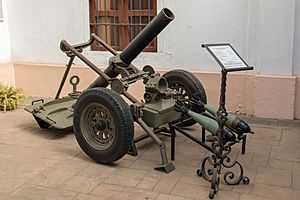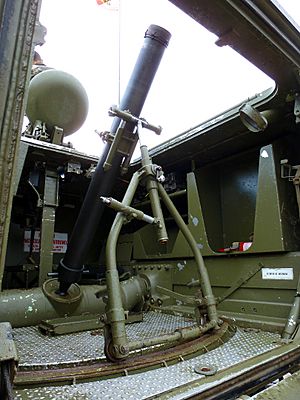Esperanza y Cia facts for kids
| Joint stock company | |
| Industry | Defence |
| Founded | 1925 |
| Founder | Juan Esperanza Salvador |
| Defunct | 1994 |
| Headquarters | , |
| Products | Explosives, Electro-optical devices |
| 1,760 million peseta (1978) | |
|
Number of employees
|
223 (1991) |
Esperanza y Cia, SA (Ecia) was a company in Spain that made equipment for defense. It was located in the city of Markina-Xemein in the Basque Country. From the very beginning, Ecia mainly focused on making mortars and the special ammunition they used.
Contents
A Look at Ecia's History
How the Company Started
The company, Esperanza y Cia SA (Ecia), was started in 1925. It was founded by a well-known businessman named Juan Esperanza Salvador. He was also one of the people who helped start another company called Astra-Unceta y Cia SA. Mr. Esperanza-Salvador used his knowledge from his earlier work to help Ecia grow.
At first, Ecia made guns using a special design from another company. Then, they designed their own semi-automatic pistol, called the ECIA pistol. They also created a light machine gun. In 1933, the company moved to Marquina.
Ecia During the Spanish Civil War
During the Spanish Civil War, the Basque Government took control of the company. They moved the factory to Derio and then to Bilbao. This was done to keep it safe from the fighting. After the war ended, the company moved back to Marquina.
In the 1940s, Ecia started making many more infantry mortars and their ammunition. These products became very important for the company's success. During the Second World War, Ecia supplied weapons to Germany.
Ecia's Role in the Arms Industry
By 1978, Ecia was the biggest exporter of weapons in Spain. It was even bigger than another company from the Basque Country, Explosivos Alaveses. At that time, seven of the top ten Spanish weapon makers were from the Basque Country.
In 1980, a group attacked a convoy carrying company materials. Six civil guards who were protecting the convoy were killed in this attack. In 1985, the head of security for the company was also killed.
The arms industry faced big problems in the 1980s. There was less demand for weapons both in Spain and from other countries. Ecia changed its name to Esperanza y Cia Explosives. It partnered with another company, Unión Explosivos Río Tinto, which bought 40% of Ecia's shares. This partnership helped Ecia survive through projects like the Euromortar.
In 1986, there were claims that Ecia had received military technology from companies in Israel. Ecia denied these claims. The company's reputation also faced challenges due to its connection with selling weapons to countries involved in conflicts. In 1992, its main shareholder, ERT, went bankrupt. Because of this, Esperanza Y Cia. closed its main factory in Markina in 1994.
A small part of Ecia's research teams joined Alaveses Explosives-Expal. That company also stopped operating in 2004. However, about 20 former Ecia workers started a new company called Ecia-Xemein in Markina in 1995. They continued to make metal parts.
What Ecia Made
Firearms and Early Weapons
In the late 1920s, Ecia created test versions of a special pistol and a machine gun. An ECIA Model 1927 machine gun was shown at an exhibition in San Sebastián. This machine gun could fire 180 rounds per minute.
Mortars: Ecia's Specialty
Ecia made mortars from the very beginning in 1925. After the Civil War, making mortars became the company's main focus. Countries like Guatemala and Chile used modern Ecia mortars.
Besides the mortars themselves, Ecia also made different types of ammunition for them. This included high explosive rounds, smoke rounds, and illumination rounds. They also made training ammunition, anti-personnel (against people) and anti-armor (against vehicles) ammunition. Ecia even made ammunition for 122 mm and 82 mm mortars.
Valero 60mm Model 1926
This mortar was first used by the Spanish military in 1926.
- Caliber: 60 mm
Valero 50mm Model 1932
The Spanish military started using this mortar in 1932.
- Caliber: 50 mm
- Ammunition weight: 780 grams
- Range: 50 to 1000 meters
- Weight: 7 kg
Valero 81mm Model 1933
This model was introduced in 1933. It replaced the 60mm model as a standard weapon for battalions.
- Caliber: 81 mm
- Ammunition weight: 4 kg
- Maximum range: 3250 meters
- Weight: 63 kg
- Tube length: 1.2 meters
120mm "Franco" Mortar
Production of this mortar began in 1942.
- Caliber: 120 mm
- Weight: 85 kg
- Maximum range: 6400 meters
- Firing Rate: 3 shots per minute
Valero-Ecia 1942 Models
Ecia produced 81mm and 120mm versions of these mortars starting in 1942.
Ecia Models 1951
These models replaced the older Valero mortars. They were lighter and came in 60mm, 81mm, and 120mm sizes.
Ecia Model 1951 81mm
This mortar could be carried by four people or a mule. It could also be used on vehicles.
- Caliber: 81 mm
- Ammunition weight: 3.935 kg (explosive) 4.154 kg (smoke)
- Range: 200 to 3145 meters
- Fire Rate: 10 to 30 shots per minute
- Elevation: 49.5° to 89.5°
- Weight in position: 66.37 kg
Ecia Model 1951 120mm
This larger mortar was designed to be towed by a vehicle.
- Caliber: 120 mm
- Ammunition weight: 16.55 kg (explosive) 17.7 kg (smoke)
- Range: 600 to 6400 meters
- Fire Rate: 5 to 10 shots per minute
- Elevation: 49.5° to 89.5°
- Weight in position: 321.62 kg
- Tube length: 1 meter
Ecia Models C, C-2, and L 60mm
The "Commando" (C) model was made for special operations. The C-2 version was used on vehicles. The L model had a bipod to increase its range to 2000 meters. These mortars were light enough for one person to use.
- Caliber: 60 mm
- Ammunition weight: 1.428 kg (explosive, smoke) 1.966 kg (illuminating)
- Maximum range: 1060 meters (C, C-2) 2100 meters (L)
- Firing rate: 30 shots per minute
- Elevation: 49.5° to 89.5°
- Weight in position: 5 kg (C) 10 kg (L)
- Tube length: 650 mm
ECIA Models L and L1 81mm
These mortars used a tripod instead of the usual bipod. A team of three people could carry them when taken apart.
- Caliber: 81.35 mm
- Ammunition weight: 4.13 kg (N) 3.2 kg (NA)
- Maximum range: 4100 meters (L) 4500 meters (L)
- Firing Rate: 15 shots per minute
- Weight in position: 43 kg (L) 45 kg (L1)
- Tube length: 1.15 meters (L) 1.45 meters (L1)
ECIA Model L 105mm
This was a larger mortar with a round base. It was designed to be moved by a two-wheeled trailer.
- Caliber: 105 mm
- Ammunition weight: 9.2 kg (HE)
- Maximum range: 7050 meters
- Firing Rate: 12 shots per minute
- Position weight: 105 kg
- Shipping weight: 239 kg
- Tube length: 1.5 meters
ECIA Model SL and L 120mm
These mortars were also transported using a two-wheeled trailer.
- Caliber: 120 mm
- Ammunition weight: 16.745 kg (N-HE) 13.195 kg (L-HE)
- Maximum range: 5000 meters (L / N-HE) 5940 meters (L / L-HE) 5700 meters (SL / N-HE) 6660 meters (SL / L-HE)
- Firing Rate: 12 shots per minute
- Position weight: 123 kg (SL) 213 kg (L)
- Shipping weight: 257 kg (SL) 316 kg (L)
- Tube length: 1.6 meters
ECIA L65/120
See also
 In Spanish: Esperanza y Cía. para niños
In Spanish: Esperanza y Cía. para niños
- Astra-Unceta y Cia SA - another company co-founded by Juan Esperanza Salvador.



